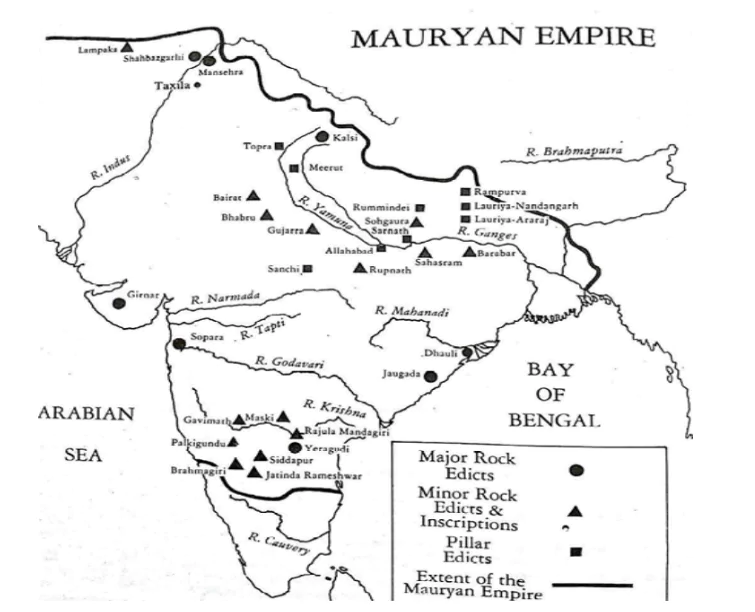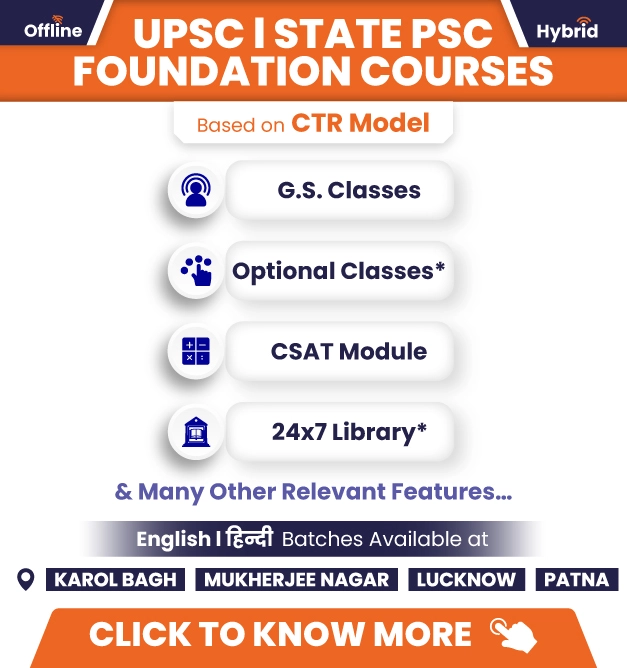Ashoka: Transformation from Conqueror to Compassionate Ruler
![]() April 27, 2024
April 27, 2024
![]() 93
93
![]() 0
0
Introduction
Ashoka, the grandson of Chandragupta Maurya, ascended to the Mauryan throne in 268 BC following a possible succession dispute among Bindusara’s sons. Known for his conversion to Buddhism and adoption of a pacifist approach, Ashoka is revered in Buddhist texts as Chakravartin.
Beginning of Ashoka
- Kalinga War: The Kalinga War was a punitive war against Kalinga, which had broken away from the Magadha Empire (Hathigumpha inscription speaks of Kalinga as a part of the Nanda Empire).
- Effects of War on Ashoka: The war’s brutality deeply affected him leading him to shift from physical occupation (Bherighosha) to cultural conquest and the promotion of dharma (Dhammaghosha).
- Shift in Ideology: After the Kalinga war, Emperor Ashoka shifted his focus from military conquest to ideological expansion, seeking to win over foreign territories through welfare measures for both humans and animals.
- Despite having ample resources, he refrained from waging further wars.
- Promoting Diplomacy: He chose to send emissaries promoting peace to the Greek kingdoms in Western Asia and Greece.
- Though his approach appeared pacifist, he did not abandon the army or give up his claim on the acquired territory of Kalinga.
- Peace Preacher: He is known for his peace policy, non-aggression, and cultural conquest.
Inscriptions of Ashoka
- Use of Inscription: First Indian king to speak directly to the people through inscriptions.
- They were generally placed on ancient highways and provided details about the empire’s policies and extent.
- Language on the Inscription: They were engraved on rocks, polished stone pillars, and caves and are found in the Indian subcontinent and Kandahar in Afghanistan.
- Inscriptions were primarily written in the Magadhi and Prakrit languages and in the Brahmi script.
- The Kandahar inscriptions are in Greek and Aramaic languages, while the two inscriptions in northwest Pakistan were in Kharosthi script.
- Number of Edicts: There are 33 edicts comprising 14 Major Rock Edicts, two known as Kalinga edicts, 7 Pillar Edicts, some Minor Rock Edicts, and a few Minor Pillar Inscriptions.
- The Major Rock Edicts extend from Kandahar in Afghanistan, Shahbazgarhi, and Mansehra in north-west Pakistan to Uttarakhand in the north, Gujarat and Maharashtra in the west, Odisha in the east, and as far south as Karnataka and Kurnool district in Andhra Pradesh.
- Minor pillar inscriptions were as far north as Nepal (near Lumbini).
- Ashoka on Inscriptions: All the edicts began with a reference to the great king, Devanampiya (beloved of the gods), and Piyadassi (of pleasing looks). It referred to Ashoka.
| James Prinsep deciphered the edicts of Ashoka in 1837. He deciphered Brahmi and Kharosthi scripts used in the earliest inscriptions and coins. |

Contemporary Rulers of Ashoka with whom he had exchanged Missions
|
Religious Policy
- Tolerant Religious Policy: Ashoka refrained from imposing Buddhism on his subjects and made gifts to non-Buddhist and anti-Buddhist sects.
- Donations to Ajivika Sects: The Barabar caves were donated to the Ajivika sects, reflecting Ashoka’s support for various religious groups.
- Dharmayatras: Ashoka’s visits to Buddhist shrines, mentioned as Dharmayatras in inscriptions, highlighted his commitment to Buddhism without imposing it on others.
- Third Buddhist Sangha: In 250 BC, Ashoka convened the Third Buddhist Sangha in Pataliputra.
- An essential outcome of the sangha was to expand the reach of Buddhism to other parts of the region by sending missionaries.
- Missionary Activities: He sent missionaries to countries like Sri Lanka, Burma, and Central Asia.
- His children, Mahinda and Sanghamitta, went to Sri Lanka to propagate Buddhism.
- They took a branch of the original bodhi tree to Sri Lanka.
- Harmonious Society: Under Ashoka, Mauryan society witnessed harmony among various religions, castes, and communities, fostering a spirit of coexistence.
Ashoka’s Administration
- Paternal Kingship: Ashoka viewed his subjects as his children, embodying a sense of care and responsibility towards them.
- Promotion of Dhamma: Ashoka urged all to follow Dhamma, and the success of his Dhamma policy is highlighted in the Kandahar inscription.
- Administrative Reforms: Ashoka appointed Rajukas for justice administration and Dharma-mahamatras for propagating Dhamma across social groups.
- Animal Protection and Social Order: He prohibited the killing of certain animals and birds and banned animal slaughter in the capital.
- His Dhamma emphasized social order, including respect for parents, Brahmanas, monks, and compassion for slaves and servants.
- Heavenly Rewards: Ashoka believed that good behavior would lead to heavenly rewards, focusing on social conduct rather than nirvana, the ultimate goal of Buddhism.
- Rotation of Officers: To prevent oppressive rule, Ashoka introduced the rotation of officers in key administrative centers like Tosali, Ujjain, and Taxila.
| Rumendei Pillar Inscription of Ashoka (Lumbini, Nepal): The inscription is in Brahmi script and Prakrit language. Ashoka visited and worshipped the place, as Shakyamuni was born there. |
Death: Ashoka died in 231 BC. After his death, the Mauryan Empire slowly disintegrated and died out. Pushiyamitra Sunga (a Mauryan general) killed the last Mauryan king, Brihadratha and usurped the throne of Patliputra.
Causes of Decline
- Brahmanical reaction: The anti-sacrifice attitude of Ashoka and Buddhism resulted in a loss to Brahmans as they received gifts during sacrifices.
- Financial strain due to the vast army, bureaucracy, and large grants to Buddhist monks.
- Oppressive rule in provinces led to revolts. During Bindusara’s reign, citizens of Taxila complained about the misrule of Dushtamatyas (wicked bureaucrats).
- Ashoka’s focus on missionary activities led him to overlook the importance of protecting the northwest frontier. As a result, the region was left vulnerable to potential threats and attacks.
- Economic advancement and the spread of material culture led to the rise of new kingdoms.
| Must Read | |
| Current Affairs | Editorial Analysis |
| Upsc Notes | Upsc Blogs |
| NCERT Notes | Free Main Answer Writing |
Conclusion
- Ashoka transformed from a ruthless conqueror to a compassionate ruler. His edicts, inscribed on pillars and rocks across the subcontinent, reflect his commitment to peaceful coexistence, social welfare, and moral principles.
- Ashoka’s reign stands as a testament to the power of moral leadership and serves as a timeless reminder of the importance of empathy and ethical governance in shaping a society.
Recommended For You
Integration of PYQ within the booklet
Designed as per recent trends of Prelims questions
हिंदी में भी उपलब्ध
UDAAN PRELIMS WALLAH
Integration of PYQ within the booklet
Designed as per recent trends of Prelims questions
हिंदी में भी उपलब्ध
<div class="new-fform">
</div>
















Latest Comments